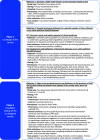Co-design and feasibility of a pharmacist-led minor ailment service
- PMID: 33482801
- PMCID: PMC7821549
- DOI: 10.1186/s12913-021-06076-1
Co-design and feasibility of a pharmacist-led minor ailment service
Abstract
Background: Community pharmacies provide an appropriate setting to deliver minor ailment services (MASs). Many community pharmacy services have been developed previously without stakeholder involvement. As a result, implementation of services may fail to produce the expected impact. The aim of this research was to co-design and test the feasibility of an Australian MAS for minor ailment presentations.
Methods: This study used co-design methodology which included two phases: (1) a focus group with stakeholders to allow the conceptualization of the service and agreement on service elements; (2) a literature review of clinical guidelines and three working meetings with a team of editors and general practitioners for the development of treatment pathways. Following this, a study evaluating the feasibility of the co-designed service was undertaken. The qualitative part of the methodology associated with the feasibility study comprised semi-structured interviews with MAS pharmacists, observation and completion of a tool by change facilitators identifying barriers and facilitators to service delivery. Qualitative data obtained for all phases were analysed using thematic analysis.
Results: The developed service included the following components: (i) an in-pharmacy consultation between the patient and pharmacist, (ii) treatment pathways accessible to pharmacists on the internet to guide consultations, (iii) existing digital communication systems used by general practice to exchange patient information, (iv) training, and (v) change facilitation. As a result of feasibility testing, twenty-six implementation factors were identified for practice change, with the main change being the simplification of the pharmacist-patient consultation and data collection processes.
Conclusions: An Australian MAS was generated as a result of co-design, while testing revealed that the co-designed service was feasible. As a result of integrating the views of multiple stakeholders, the designed MAS has been adapted to suit healthcare practices, which may increase the acceptance and impact of MAS when implemented into practice.
Keywords: Co-design; Community pharmacy; Community pharmacy services; Dissemination and implementation; Health services; Minor ailment services; Qualitative research; Self-care.
Conflict of interest statement
The authors declare that they have no competing interests.
Similar articles
-
A qualitative study of stakeholder views and experiences of minor ailment services in the United Kingdom.Res Social Adm Pharm. 2019 May;15(5):496-504. doi: 10.1016/j.sapharm.2018.06.014. Epub 2018 Jun 20. Res Social Adm Pharm. 2019. PMID: 29941403
-
A stakeholder co-design approach for developing a community pharmacy service to enhance screening and management of atrial fibrillation.BMC Health Serv Res. 2018 Feb 27;18(1):145. doi: 10.1186/s12913-018-2947-7. BMC Health Serv Res. 2018. PMID: 29486758 Free PMC article.
-
Cluster randomised controlled trial evaluating the clinical and humanistic impact of a pharmacist-led minor ailment service.BMJ Qual Saf. 2020 Nov;29(11):921-931. doi: 10.1136/bmjqs-2019-010608. Epub 2020 Mar 5. BMJ Qual Saf. 2020. PMID: 32139400 Clinical Trial.
-
Educational needs of community pharmacy staff in minor ailment service delivery: A systematic scoping review.Curr Pharm Teach Learn. 2020 Oct;12(10):1269-1287. doi: 10.1016/j.cptl.2020.05.013. Epub 2020 Jun 23. Curr Pharm Teach Learn. 2020. PMID: 32739065
-
A review of international pharmacy-based minor ailment services and proposed service design model.Res Social Adm Pharm. 2018 Nov;14(11):989-998. doi: 10.1016/j.sapharm.2017.12.004. Epub 2018 Jan 5. Res Social Adm Pharm. 2018. PMID: 29444752 Review.
Cited by
-
Role of community pharmacy and pharmacists in self-care in Brazil.Explor Res Clin Soc Pharm. 2023 Apr 23;10:100274. doi: 10.1016/j.rcsop.2023.100274. eCollection 2023 Jun. Explor Res Clin Soc Pharm. 2023. PMID: 37181500 Free PMC article.
-
Examining equity in a void of evidence - Pharmacist minor ailments services and the role of systematic reviews.Explor Res Clin Soc Pharm. 2022 Aug 23;7:100174. doi: 10.1016/j.rcsop.2022.100174. eCollection 2022 Sep. Explor Res Clin Soc Pharm. 2022. PMID: 36072438 Free PMC article.
-
Implementation factor mapping of a pilot study of point-of-care C-reactive protein testing for respiratory tract infections in community pharmacy.Explor Res Clin Soc Pharm. 2022 Jun 2;6:100147. doi: 10.1016/j.rcsop.2022.100147. eCollection 2022 Jun. Explor Res Clin Soc Pharm. 2022. PMID: 35733607 Free PMC article.
-
Identification of high-risk patients for referral through machine learning assisting the decision making to manage minor ailments in community pharmacies.Front Pharmacol. 2023 Jul 11;14:1105434. doi: 10.3389/fphar.2023.1105434. eCollection 2023. Front Pharmacol. 2023. PMID: 37497107 Free PMC article.
-
Consumer perceptions of community pharmacists' involvement in antimicrobial stewardship: A quantitative study.Explor Res Clin Soc Pharm. 2023 May 20;10:100281. doi: 10.1016/j.rcsop.2023.100281. eCollection 2023 Jun. Explor Res Clin Soc Pharm. 2023. PMID: 37274416 Free PMC article.
References
-
- World Health Organization. Self-care in the context of primary health care URL: https://apps.who.int/iris/handle/10665/206352 [accessed 2020-07-19].
-
- Wanless D Securing our future health: taking a long-term view. HM Treasury London; 2002.
MeSH terms
LinkOut - more resources
Full Text Sources
Other Literature Sources
Research Materials


